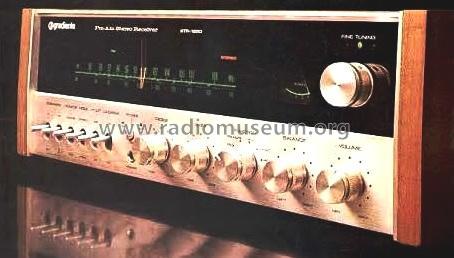Fm-Am Stereo Receiver STR-1250
Gradiente Eletrônica S.A.; São Paulo
- Pays
- Brésil
- Fabricant / Marque
- Gradiente Eletrônica S.A.; São Paulo
- Année
- 1974 ?
- Catégorie
- Radio - ou tuner d'après la guerre 1939-45
- Radiomuseum.org ID
- 331388
Cliquez sur la vignette du schéma pour le demander en tant que document gratuit.
- No. de transistors
- Semi-conducteurs présents
- Semi-conducteurs
- Principe général
- Super hétérodyne (en général)
- Gammes d'ondes
- PO et FM
- Particularités
- Equipement HIFI
- Tension / type courant
- Alimentation Courant Alternatif (CA) / 110; 220 Volt
- Haut-parleur
- - Ce modèle nécessite des HP externes
- Puissance de sortie
- 64 W (sans distorsion)
- Matière
- Boitier en bois
- De Radiomuseum.org
- Modèle: Fm-Am Stereo Receiver STR-1250 - Gradiente Eletrônica S.A.; São
- Forme
- Appareil d'étagère
- Dimensions (LHP)
- 430 x 140 x 350 mm / 16.9 x 5.5 x 13.8 inch
- Remarques
-
Inputs: Phono (moving magnet), Tape, Aux and Mic
Output power: 2 x 32 W RMS into 8 Ω, 2 x 40 W RMS into 4 Ω
AC outlets: 2 (110 - 220 V)There are different versions of this receiver, namely with the following prints on the back:
- IGB - Amazonia S/A., Av. Assai
Industria Brasileira, C.G.C. 04.209.912/0001-29
Produzida na Zona Francia de Manaus
- Made in Brazil
The schematic indicates:
- Gradiente - Receiver STR 1250 C / Monobloco Alps
- IGB - Amazonia S/A., Av. Assai
- Poids net
- 10.2 kg / 22 lb 7.5 oz (22.467 lb)
- Auteur
- Modèle crée par Antonio Rabitti. Voir les propositions de modification pour les contributeurs supplémentaires.
- D'autres Modèles
-
Vous pourrez trouver sous ce lien 34 modèles d'appareils, 34 avec des images et 5 avec des schémas.
Tous les appareils de Gradiente Eletrônica S.A.; São Paulo
Contributions du forum pour ce modèle: Gradiente Eletrônica: Fm-Am Stereo Receiver STR-1250
Discussions: 1 | Publications: 1
With reference to the product Gradiente model STR-1250 it was added in the text by the administrators that this model probably has Japanese parts. This is not correct. Gradiente produced this model (and others that I'll upload) entirely.
What happens is that our hi-fi audio market followed Japanese standards mainly with regard to connections.
Philips unsuccessfully tried to impose the DIN standard, but had to surrender to the market imposition created by other local hi-fi audio manufacturers (Gradiente, Polyvox, Quasar, CCE, Spectro, Gavox, Greynolds, etc.) who adopted the Japanese standard for connections .
Antonio Rabitti
Mike Edwards † 25.10.21, 08.Aug.21


